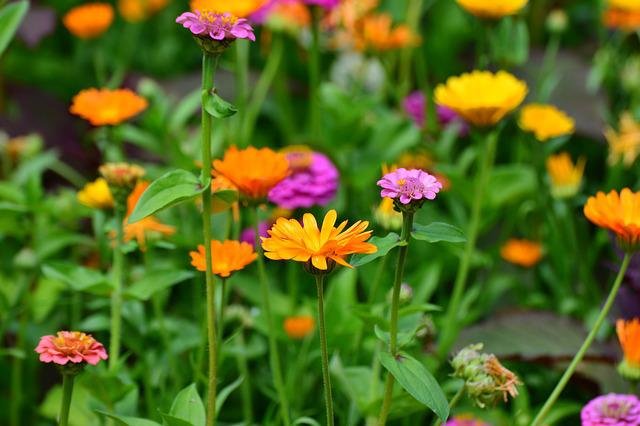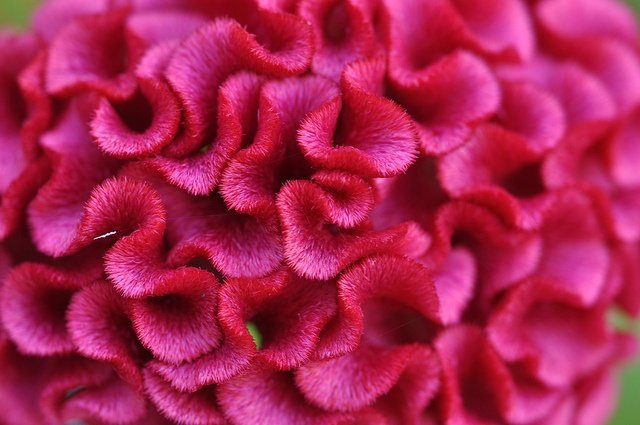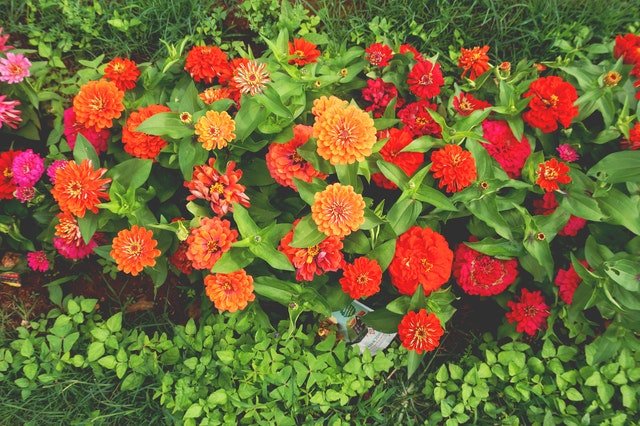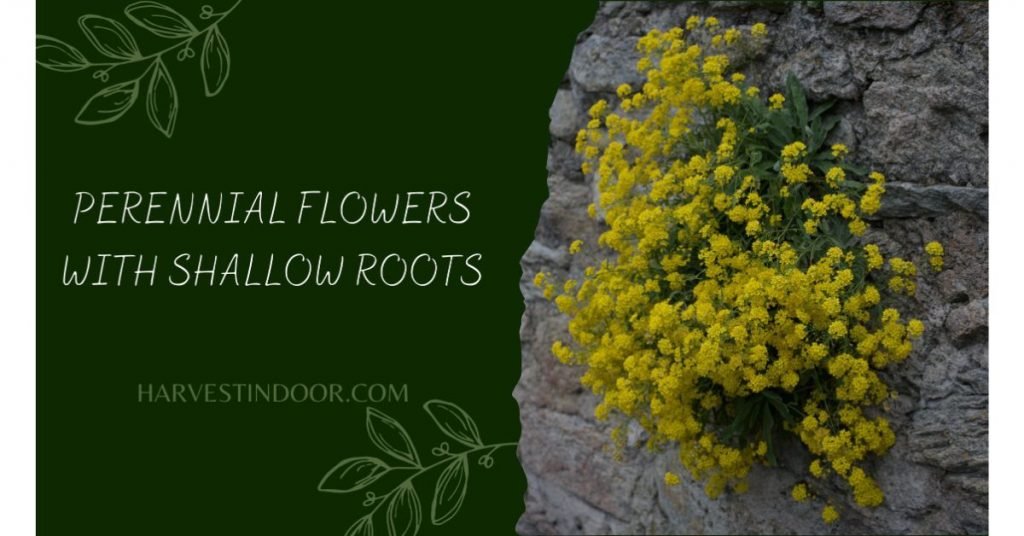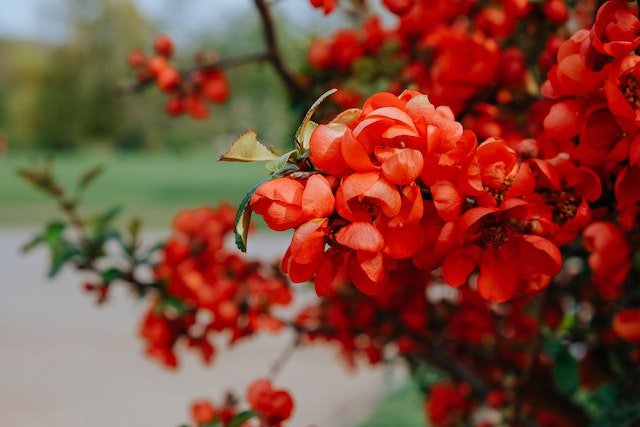Last updated on June 9th, 2023 at 07:10 am
As a landscaping enthusiast, you’ve probably encountered the challenge of what to plant behind your hydrangeas. While hydrangeas are an excellent choice for a beautiful garden, they can leave a gap in your landscaping that requires careful consideration. The space behind your hydrangeas is an excellent opportunity to add additional color, texture, and interest to your garden. In this article, we’ll guide you through the best plants to grow behind hydrangeas to elevate your landscaping game and make your garden pop.
Table of Contents
Understanding Hydrangeas

Before we dive into the best plants to plant behind hydrangeas, let’s take a moment to understand these beautiful flowers. Hydrangeas are deciduous shrubs that can grow up to 10 feet tall, although some varieties stay small. They bloom in summer and early fall, producing clusters of white, pink, blue, or purple flowers. Hydrangeas prefer partial to full shade and moist, well-draining soil.
Best Plants to Grow Behind Hydrangeas
When choosing plants to grow behind your hydrangeas, consider plants that can thrive in partial to full shade and complement your hydrangeas’ color and texture. Here are some excellent options to consider:
Ferns
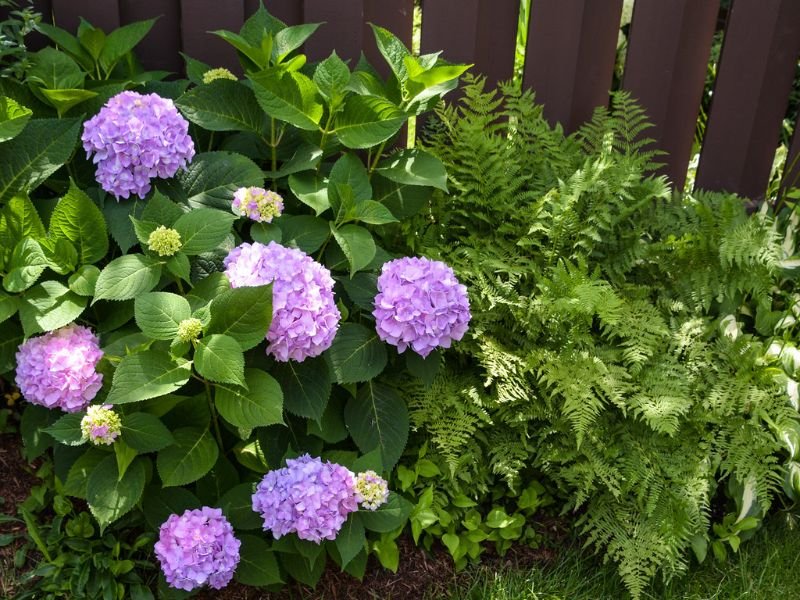
Ferns are a perfect choice for a lush and green backdrop behind your hydrangeas. They come in various colors and textures and can add depth and interest to your landscaping.
Planting ferns behind hydrangeas is a good idea for several reasons.
- Firstly, it adds aesthetic appeal by creating a contrasting backdrop of lush green foliage. The feathery texture of the ferns enhances the overall beauty of the hydrangea display.
- Secondly, ferns provide shade and help regulate moisture, creating a microclimate that suits hydrangeas’ preferences for partial shade and moist soil.
- Additionally, ferns enrich the soil as they decay, improving its quality for the growth of hydrangeas.
- They also suppress weed growth by shading the soil and preventing erosion with their fibrous root system.
Overall, planting ferns behind hydrangeas enhances their growth environment and contributes to their health and beauty.
Hostas
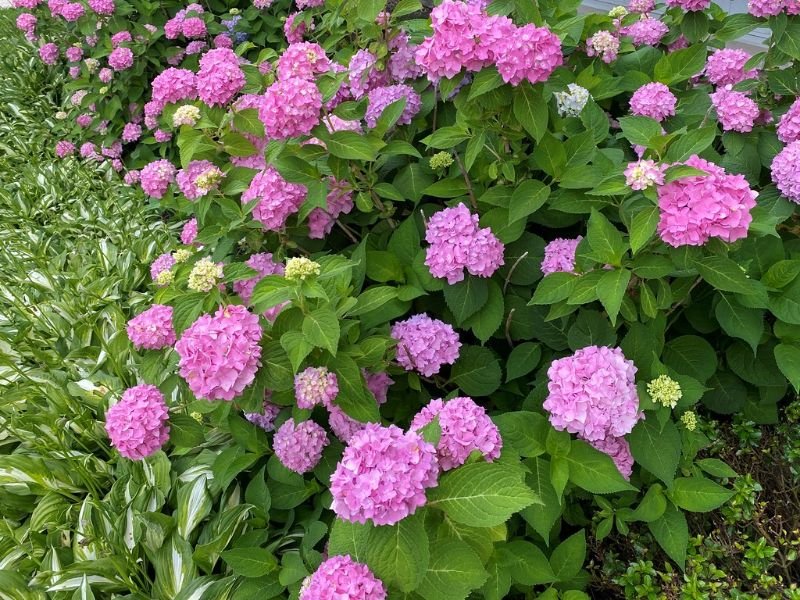
Hostas are a classic choice for planting behind hydrangeas. Their big, bold leaves come in a variety of colors and patterns, and they’re easy to care for.
Planting hostas behind hydrangeas is a good idea for several reasons.
- First, hostas provide a beautiful and contrasting foliage display with their lush and vibrant leaves, which complement the blooms of hydrangeas. The different textures and colors of the two plants create an appealing visual contrast.
- Second, hostas are shade-tolerant plants, making them an ideal choice for planting behind hydrangeas, which prefer partial shade. They can help create a shaded area that protects the hydrangeas from excessive sunlight and heat.
- Additionally, hostas are known for their dense and spreading growth habit, which can help suppress weed growth and provide ground cover, creating a neat and well-maintained appearance for the garden.
Overall, planting hostas behind hydrangeas enhances the aesthetic appeal, provides shade, and contributes to a well-balanced and visually pleasing garden design.
Heucheras
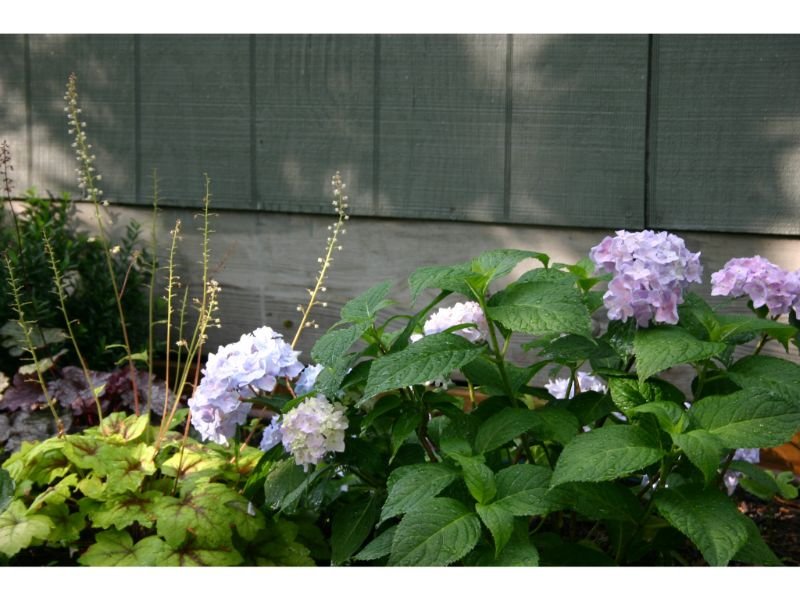
Heucheras, also known as coral bells, come in a range of colors, from purple to peach to lime green. Their delicate leaves and tiny flowers can add a touch of whimsy to your garden.
Astilbes
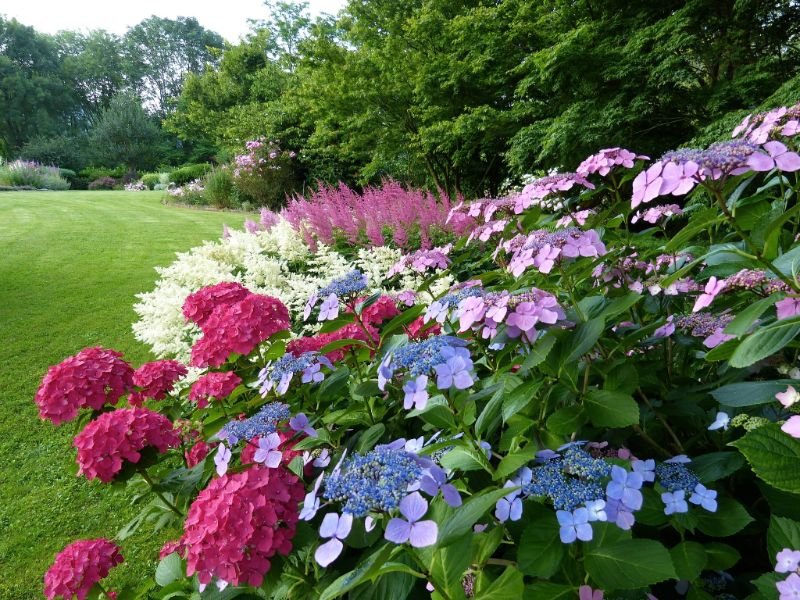
Astilbes are a low-maintenance option that produces gorgeous pink, red, and white plume-like flowers. They’re perfect for adding height and color to your garden.
Planting Astilbes behind hydrangeas is a good idea for several reasons.
- First, Astilbes offer a beautiful contrast to the large, showy blooms of hydrangeas with their feathery and delicate flower plumes. The combination of the two plants creates an interesting visual display in the garden.
- Second, Astilbes are shade-loving plants that thrive in moist soil conditions, which makes them compatible companions for hydrangeas that prefer partial shade and moist environments. They can help create a microclimate that suits the growing needs of hydrangeas, providing them with the right amount of shade and moisture.
- Additionally, Astilbes bloom in various colors, including shades of pink, white, and red, which can complement the color palette of hydrangeas, adding depth and diversity to the garden.
Overall, planting Astilbes behind hydrangeas enhances the overall aesthetics, provides suitable growing conditions, and adds color and texture to the garden landscape.
Japanese Forest Grass

Japanese Forest Grass is a slow-growing grass that can add an exotic touch to your landscaping. Its yellow-green foliage can complement your hydrangeas’ color and texture and add visual interest to your garden.
Growing Japanese Forest Grass behind hydrangeas is a good idea for several reasons.
- First, Japanese Forest Grass, also known as Hakonechloa, has a graceful and cascading growth habit, which provides a beautiful contrast to the upright and bushy nature of hydrangeas. The combination of the two plants creates a visually appealing layered effect in the garden.
- Second, Japanese Forest Grass thrives in shade or partial shade, making it an ideal companion for hydrangeas that prefer similar light conditions. It can create a lush and verdant backdrop for the hydrangeas, enhancing their overall beauty.
- Additionally, Japanese Forest Grass has striking foliage that ranges in color from vibrant green to golden or variegated tones, adding texture and interest to the garden. This grass also offers a soft and flowing texture that complements the bold and voluminous blooms of hydrangeas.
Hellebores
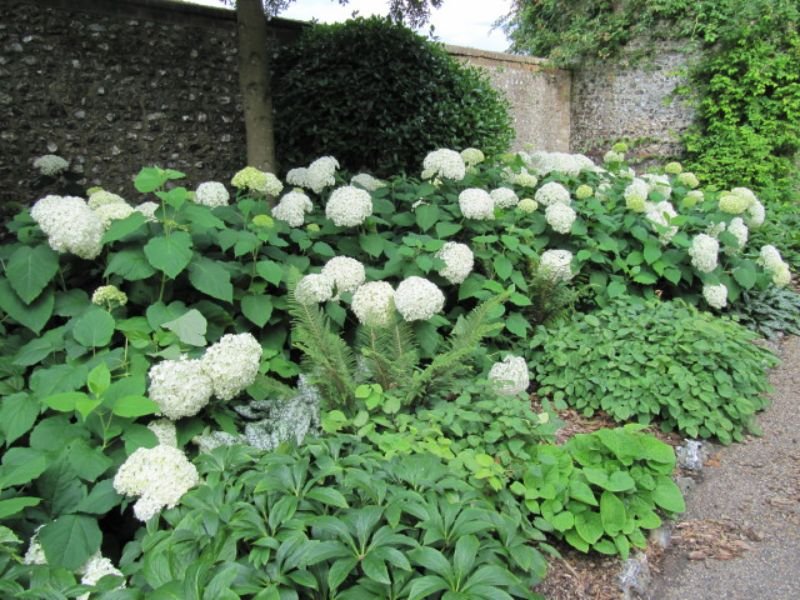
Hellebores are winter-blooming plant that produces delicate flowers in shades of pink, white, and purple. Their evergreen leaves can add texture and color to your garden throughout the year.
Growing Hellebores behind hydrangeas is a good idea for several reasons.
- Firstly, Hellebores, also known as Lenten roses, are shade-loving plants that thrive in the same conditions as hydrangeas. Planting them together allows you to maximize the use of space and create a cohesive garden design.
- Secondly, Hellebores bloom early in the spring, often before or at the same time as hydrangeas. Their delicate and colorful flowers provide an attractive backdrop to the larger, showy blooms of the hydrangeas. This combination adds depth and visual interest to your garden, extending the flowering season and creating a beautiful transition between seasons.
- Additionally, Hellebores have evergreen or semi-evergreen foliage that remains attractive throughout the year, even when the flowers have faded. This foliage serves as a lush and verdant backdrop to the hydrangeas, enhancing their overall appearance.
- Lastly, Hellebores are low-maintenance plants that require little care once established. They are deer-resistant and can tolerate a wide range of soil conditions.
By planting Hellebores behind hydrangeas, you can create a stunning and harmonious garden display that combines the elegance of both plants.
Bleeding Hearts
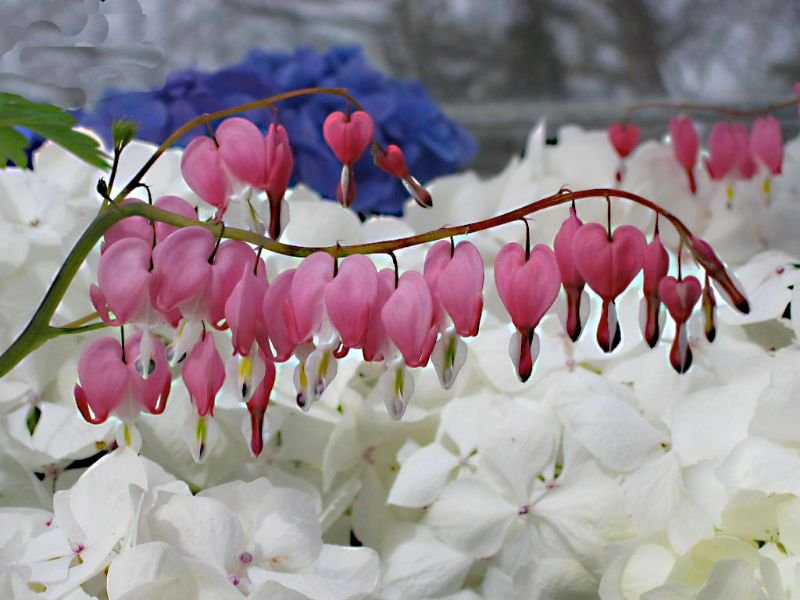
Bleeding Hearts are a classic cottage garden plant that produces heart-shaped flowers in shades of pink and white. They’re perfect for adding a touch of romance to your garden.
Growing Bleeding Hearts behind hydrangeas is a good idea for several reasons.
- Firstly, Bleeding Hearts (Dicentra) are shade-loving perennials that thrive in similar growing conditions as hydrangeas. Planting them together allows you to maximize the use of space and create a harmonious garden design.
- Secondly, Bleeding Hearts produce delicate, heart-shaped flowers that hang gracefully from arching stems. The unique shape and vibrant colors of their blooms provide an interesting contrast to the large, rounded flower clusters of hydrangeas. This combination adds visual appeal and texture to your garden, creating a captivating display.
- Additionally, Bleeding Hearts have attractive fern-like foliage that remains lush and green throughout the growing season, even when the flowers are not in bloom. This foliage serves as a beautiful backdrop to the hydrangeas, enhancing their overall aesthetic.
- Furthermore, Bleeding Hearts are relatively low-maintenance plants that require minimal care once established. They are known for their long blooming period, bringing continuous color to your garden.
Lady’s Mantle
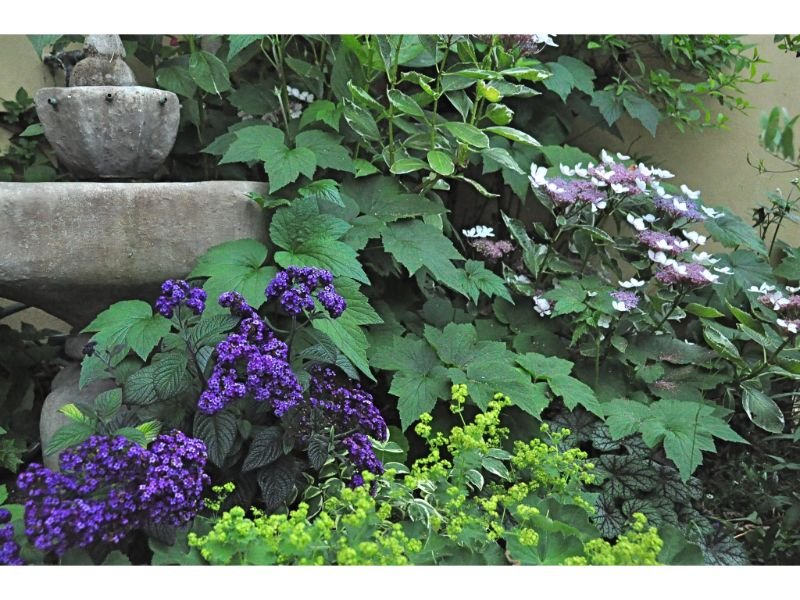
Lady’s Mantle is a low-growing, hardy perennial that produces green, velvety leaves and tiny, chartreuse flowers. Its leaves can collect dewdrops and raindrops, making it an excellent choice for adding visual interest to your garden.
Growing Lady’s Mantle (Alchemilla mollis) behind hydrangeas is a good idea for several reasons.
- Firstly, Lady’s Mantle is a perennial plant that thrives in similar growing conditions as hydrangeas, particularly in partial shade or dappled sunlight. Planting them together allows you to create a cohesive and visually pleasing garden design.
- Secondly, Lady’s Mantle has attractive foliage characterized by soft, velvety leaves that catch and hold dewdrops, creating a sparkling effect in the garden. The scalloped edges of the leaves also add texture and interest to the overall landscape. When positioned behind hydrangeas, the unique foliage of Lady’s Mantle serves as a beautiful backdrop, enhancing the visual impact of the hydrangea blooms.
- Additionally, Lady’s Mantle produces clusters of small, chartreuse-yellow flowers that appear in early summer. These delicate flowers provide a subtle and complementary contrast to the bold and showy blossoms of hydrangeas. The combination of the hydrangeas’ vibrant flowers and the soft, elegant foliage of Lady’s Mantle creates a harmonious and visually appealing garden display.
- Lastly, Lady’s Mantle is a low-maintenance plant that requires minimal care once established. It is known for its ability to attract beneficial insects, such as bees and butterflies, making it a valuable addition to any garden.
By planting Lady’s Mantle behind hydrangeas, you can create a beautiful and dynamic garden landscape that showcases the unique qualities of both plants.
Tips for successful planting behind hydrangeas
When selecting plants to plant behind hydrangeas, it’s important to choose plants that can thrive in the same growing conditions as hydrangeas.
- Hydrangeas typically prefer moist, well-drained soil that is slightly acidic. The ideal pH range for hydrangeas is between 5.0 and 6.0. Therefore, it’s important to choose plants that can tolerate similar soil conditions.
- Another important tip is to select plants with contrasting foliage and flowers to add visual interest and depth to your garden. Consider using plants with different textures and heights, such as ferns or grasses, to create a layered effect behind your hydrangeas. You can also experiment with different colors to complement or contrast with the color of your hydrangeas.
- Additionally, hydrangeas require moderate amounts of moisture to thrive. Depending on the climate and weather conditions in your area, you may need to water your hydrangeas and the plants behind them regularly. Choosing plants that can tolerate similar moisture levels can help ensure that all plants in your garden thrive.
- Another factor to consider when choosing plants to plant behind hydrangeas is light exposure. Hydrangeas typically prefer partial shade, so it’s important to choose shade-tolerant plants that can grow well in similar light conditions. Some examples of shade-tolerant plants that can complement hydrangeas include hostas, ferns, and astilbes.
- When selecting plants to plant behind hydrangeas, it’s also important to consider their mature size. Overcrowding can be a common problem in gardens, and planting plants that are too large or grow too quickly behind hydrangeas can create a visually cluttered look. Therefore, it’s important to choose plants that won’t grow too large or spread too quickly and that can be easily maintained.
Common mistakes to avoid when planting behind hydrangeas
When planting behind hydrangeas, there are a few common mistakes to avoid to ensure that your garden looks its best.
- One of the most common mistakes is planting too close to the hydrangeas, which can lead to overcrowding and competition for resources. Be sure to give your plants enough space to grow and mature, and to consider their mature size when planning your garden.
- Another common mistake is planting invasive species that can take over your garden and compete with your hydrangeas. Be sure to research the plants you are considering and choose ones that are well-behaved and won’t cause problems in your garden.
- It’s also important to avoid planting plants with similar foliage or flowers right behind your hydrangeas. This can create a visually overwhelming effect and detract from the beauty of your hydrangeas. Instead, consider using plants with contrasting colors and textures to create a more interesting and harmonious look.
- Finally, make sure to choose plants that are well-suited to your growing conditions and climate. If you plant species that aren’t adapted to your region, they may struggle to thrive and detract from the overall health and beauty of your garden.
Conclusion
When choosing what to plant behind your hydrangeas, consider plants that can thrive in partial to full shade and complement your hydrangeas’ color and texture. Ferns, hostas, heucheras, astilbes, Japanese Forest Grass, hellebores, bleeding hearts, and lady’s mantle are all excellent options to consider. With the right plants, you can elevate your garden and create a beautiful, cohesive landscape.
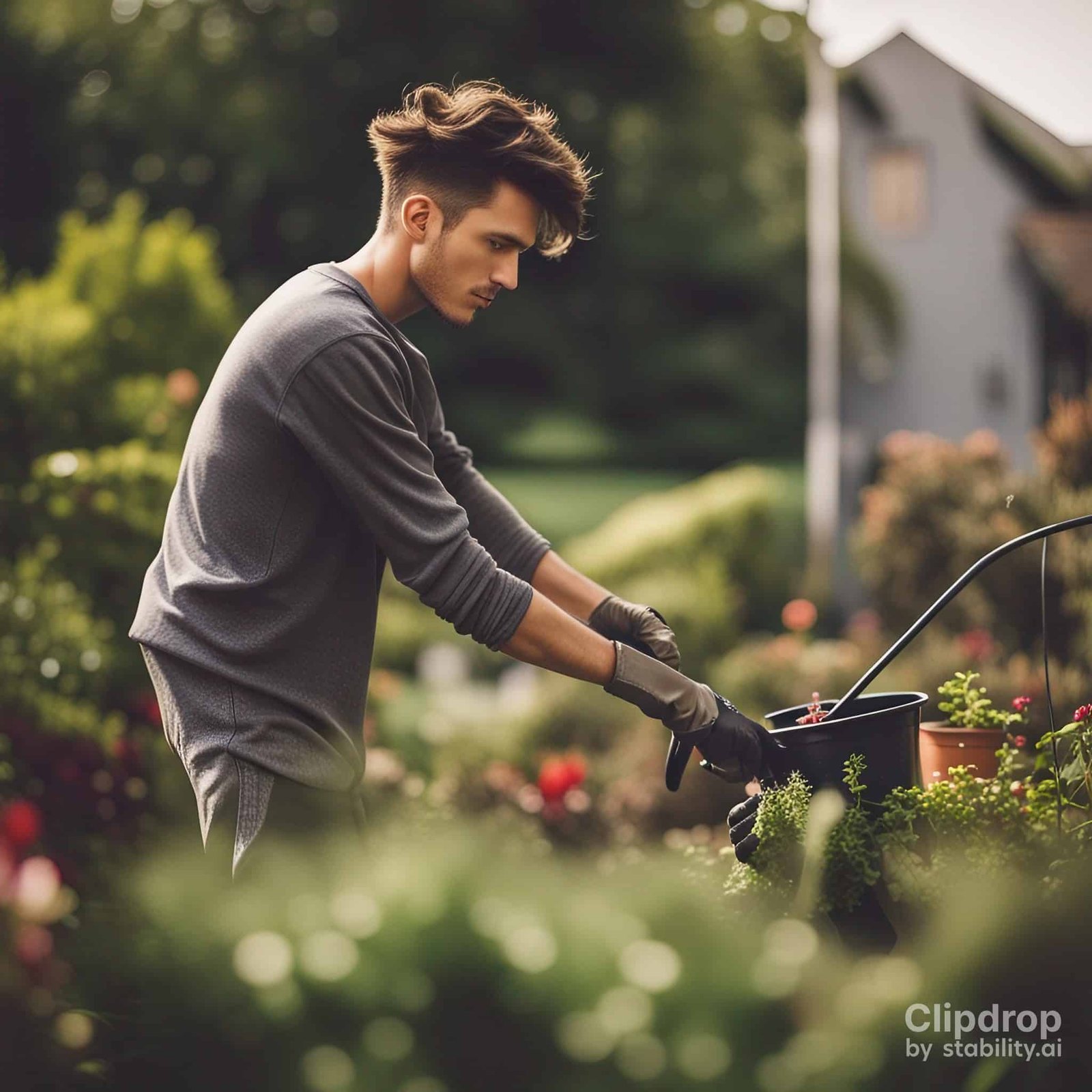
Gardening is my passion and growing plants indoors has always been a stress relief for me. Grow a banana tree in my apartment once (although failed to produce bananas).


